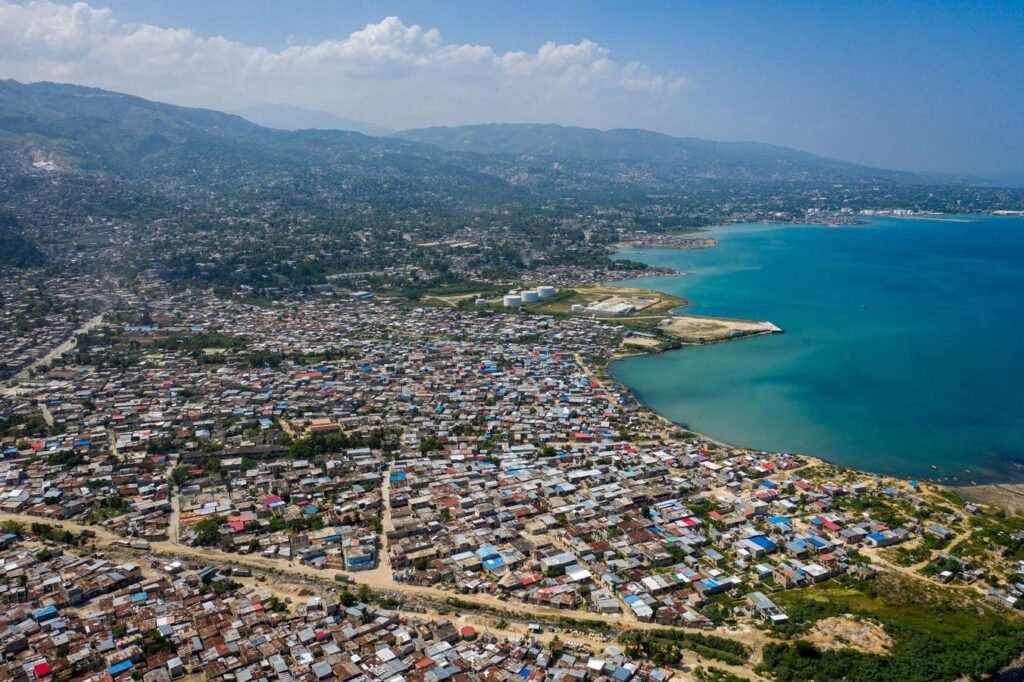Aerial view of the Martissant neighborhood of Port-au-Prince, Haiti,
As the world mourns yet another crisis in Haiti, it’s hard to remain optimistic about a country that has endured catastrophic natural disasters and pernicious colonial interventions. As the first independent nation to emerge from African slaves resettled in 1804, Haiti had much promise at its beginning. In fact, the Haitians ended up controlling all of Hispaniola from 1822 to 1844 to also end slavery in the Spanish part of the island. The nascent state of Haiti is beset by marginalization by its neighbors, particularly the United States. The US government didn’t even recognize Haiti until 1861 out of fear that a slave revolt against the French colonialists who created the country might inspire similar unrest on the plantations of the South. During the Cold War, Western nations supported despotic elites to serve their own interests in the region, but in recent years, there has been a more genuine commitment to helping Haiti out of poverty. Haiti is now the poorest country in the Western Hemisphere, plagued by natural disasters and malevolent foreign intervention for decades.
A decade ago, I was invited to Haiti to speak at a conference organized by the World Bank to examine the revival of the country’s mining industry. The discovery of mineral deposits with an estimated value at current prices of approximately $20 billion had brought some cautious optimism to some parts of the country. There was great concern and expectation about the prospect of minerals providing domestic revenue despite continued dependence on aid. Haiti’s only significant experience with modern mining was a bauxite mine operated by the Reynolds Corporation in the Miragoane area, dating back to 1941. Between then and 1982, the country exported 13.3 million tons of bauxite from Haiti to the alumina refinery in Corpus Christi, Texas. Haitian bauxite accounted for nearly a fifth of Reynolds’ bauxite acquisition during that period, and Reynolds had access to 150,000 hectares, displacing thousands of Haitian families.
Currently, the largest private service sector investment in Haiti so far is the Royal Caribbean’s Labadee Cruise Ship Resort, which I had the opportunity to visit a few years earlier on a family vacation. There are important ecological factors to consider before mining proceeds and there are funding resources available Haiti through mechanisms such as the Critical Ecosystem Fund which has supported some grants in the northern region of Haiti where mining is planned. Minerals can provide a revenue cushion to countries when there is a downturn in other sectors of the economy. Diversification of revenue sources for the government is of course necessary. The COVID pandemic has undoubtedly shown the vulnerabilities of tourism in terms of revenue reliability, as have the numerous hurricanes and natural disasters over the years. This vulnerability exists for both countries on the island of Hispaniola — Haiti and the Dominican Republic. However, their development trajectories have diverged strikingly. The Dominican Republic is one of the largest gold producers in the region and also has a thriving tourism economy.
While attending a seminar at a NASA event in Washington about twenty years ago, I remember being showed a satellite image of the island of Hispaniola. The speaker asked everyone, can you tell where the border between Haiti and the Dominican Republic is? Everyone nodded in unison because you could see a dramatic difference in land coverage from the satellite image – which coincided with where the border was. The Haitian side showed much less vegetation in the border area. Pulitzer Prize-winning author and environmentalist Jared Diamond devoted a chapter of his book Collapse in why the Dominicans protected their forests while the Haitians degraded theirs. The border photo was featured in Al Gore’s 2006 documentary “An Inconvenient Truth.”
Then there were revisionist accounts arguing that “one of the most repeated facts about Haiti is a lie.” The underlying charge is that the deforestation disparity is exaggerated and a reflection of white prejudice against poor Haitians. However, there is now ample evidence from the field to show that there is indeed clearly higher deforestation on the Haitian side. A 2018 study published by the Proceedings of the National Academy of Sciencesusing multiple methods and focusing on primary forests, estimated that such areas of high biodiversity in Haiti decreased from 4.4% of the total area in 1988 to 0.32% in 2016. However, in a remarkable display of adaptability, the Haitians managed to find a way to carefully use the managed forest lands known as rakbwa alongside reforestation, in which trees are grown, killed and sold for construction or charcoal, played a role in maintaining the country’s tree cover.
Haiti deserves the immediate attention of the development community as a recipient of investment, not handouts. Security must be established first and a political solution to deal with anarchist gangs is of course the first priority. However, soon after securing some semblance of governance, there is a need to review various ways to help the country harness its wealth of resources. Although there are risks to investors and communities from mismanaged extractive industries, the status quo is also untenable. Haitians have shown remarkable resilience in the face of massive earthquakes, hurricanes and an unrelenting wave of outside intervention. They should not be relegated to permanent underdevelopment. A tight coupling between security and serious industrial investment is desperately needed in Haiti.
